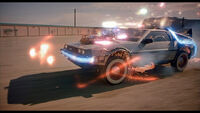No edit summary |
No edit summary |
||
| Line 11: | Line 11: | ||
The [[Jules Verne Train]] created similar effects, but it is unknown whether it left a trail of fire behind. |
The [[Jules Verne Train]] created similar effects, but it is unknown whether it left a trail of fire behind. |
||
| − | [[Image:Screen halo preflash 1955.JPG|thumb|200px|The halo before the flash in 1955]] |
+ | [[Image:Screen halo preflash 1955.JPG|thumb|200px|The halo before the flash in 1955.]] |
| + | [[Image:Screen flash 1955.JPG|thumb|200px|The flash afterward.]] |
||
On the opposite end of the temporal displacement, in the arrival time, three consecutive flashes would occur, announcing the incoming vehicle. Each flash was preceded by a halo that condensed to form the flash. On the third flash, the time machine arrived. |
On the opposite end of the temporal displacement, in the arrival time, three consecutive flashes would occur, announcing the incoming vehicle. Each flash was preceded by a halo that condensed to form the flash. On the third flash, the time machine arrived. |
||
Revision as of 04:46, 30 September 2007

On its first test.
Temporal displacement, also known as "breaking the time barrier", was the process of time traveling. The DeLorean time machine did so by reaching a speed of 88 mph, while powered by plutonium to create a nuclear reaction that would wield 1.21 gigawatts of power. On the exterior was a frame of coils that was welded to the stainless steel chassis of the original DeLorean DMC-12. This helped the time machine create a hole in the space-time continuum allowing it to travel to another time set on the time circuits, if turned on.
The results of temporal displacement were to put it best: wild. First the coils would glow in a fluorescent blue. Internal diodes would flash faster as well as the flux capacitor. A bright white field of energy would form at the front of the vehicle. At 88 mph, the entire car would vanish in a flash of blinding light and the sequence would be complete.

The glowing coils
From an observer outside the vehicle, the car would seem to explode in a large cloud of particles and leave a trail of fire in its wake. From inside the vehicle, the flash would occur instantaneously and the resulting landscape in front of the DeLorean would change as a result of time being reversed or forwarded.
Interestingly, the fire trails would continue into thin air, as when the DeLorean was struck by lightning while flying and when the DeLorean crossed the open Shonash Ravine.

The DeLorean begins the process in 1955.
The Jules Verne Train created similar effects, but it is unknown whether it left a trail of fire behind.

The halo before the flash in 1955.

The flash afterward.
On the opposite end of the temporal displacement, in the arrival time, three consecutive flashes would occur, announcing the incoming vehicle. Each flash was preceded by a halo that condensed to form the flash. On the third flash, the time machine arrived.
Behind the scenes
To create these visual effects on screen, there was a mixture of live filming and months of post-production at ILM.
For example, the fire trails were created by laying out a chemical compound in two strips on the street and lighting them. Other effects on the car itself were produced by remote triggering. The breaking of the time barrier was signaled by a white light that flashed at that instance.
